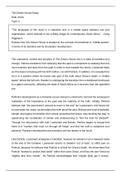Essay
Transitional Spaces - Essay
This essay covers the theme of transitional spaces in The Dream House, with specific reference to the characters of Patricia and Looksmart as well as Dwaleni as an allegory for South Africa. It has been marked and received 29/30.
[Show more]




